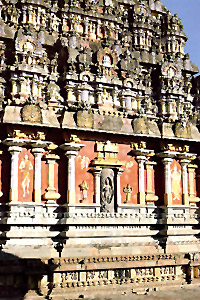 The remarkable Chola sculptures adorned the temple walls in South India. Most of these temples were dedicated to either to Lord Shiva or Lord Vishnu. These magnificent structures were built according to temple Vastu Shastra. Apart from the temple sculptures the bronze sculptures thrived too under the Chola kings. The 11th and 12th century Chola sculptures exuded elegance, rhythmic movement and grace. One of the finest examples of Chola sculpture is that of the Nataraja (Lord Shiva in dancing pose).
The remarkable Chola sculptures adorned the temple walls in South India. Most of these temples were dedicated to either to Lord Shiva or Lord Vishnu. These magnificent structures were built according to temple Vastu Shastra. Apart from the temple sculptures the bronze sculptures thrived too under the Chola kings. The 11th and 12th century Chola sculptures exuded elegance, rhythmic movement and grace. One of the finest examples of Chola sculpture is that of the Nataraja (Lord Shiva in dancing pose).
The history of Chola art and architecture began with the splendid temples. During the early Chola period several Shaivite and Vaishnavite temples were constructed by Aditya I and Parantaka I. One of the important features of Chola sculptures then was that the hugeness was missing. The architecture of the early Chola temples consisted of comparatively smaller structures which were made with bricks. The sculpture of Vijayalacholeswaram near Pudukkottai in Tamil Nadu is a perfect example of this kind of art. Other than these the architecture and sculpture of Koranganatha Temple also belongs to this era. The main architectural elements that are to be found in the temples of Chola dynasty are garbhagriha, vimana and circumbulatory corridor. Sculpture of Muvarkovil Temple is another outstanding Chola temple.
It was Rajaraja Chola who gave a great boost to the Chola sculptures ands architecture. Some of the prominent temples from this period are the architecture and sculpture of Brihadiswara Temple in Tanjore, sculpture of Gangaikonda Cholapuram Temple, sculpture of Tiruvalisvaram Temple and the sculpture of Shiva Temple. These temples were composed of sculptures and reliefs and reflect a maturity in the style of the Chola art. The Chola sculptures in these temples also consisted of comic figures. As far as the architecture of the Chola temples are concerned the buildings have profusely sculpted gopurams, majestic vimanas, garbhagrihas, mandapas and these were built on high plinths. The temples during the middle Chola period were built entirely of granite, a hard rock.
One of the main features of the Chola sculptures was that the most trifle details were taken into account. The sculptures were intricately done. Besides the usual images of gods and goddesses foliage sculpture, perforated windows, animal imageries and others were recurrent motifs as well. The elegance and stateliness of these temples are impressive beyond doubt.
The sculpture of Airavateswara Temple (Darasuram) belongs to later Chola period. Stone pillars, gopurams and well carved sculptures are the main characteristics of the Chola temples. This particular temple belongs to the 12th century AD. Another fine example from this age is the architecture and sculpture of sculpture of Kampaharesvara Temple (Tribhuvanam).
The Chola bronze sculptures also carved a special niche for themselves. In fact the bronze sculptures were created by following the lost wax technique or Cire Perdure. In fact the sculptors followed the Indian `Shilpa shashtra.` Their beauty, elegance, expressive visages and rhythmic movement characterised these sculptures. The Chola sculptures, thus, are known even today for their brilliance.



